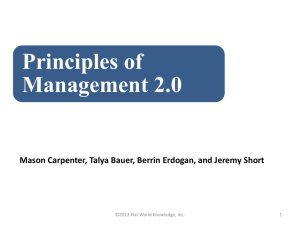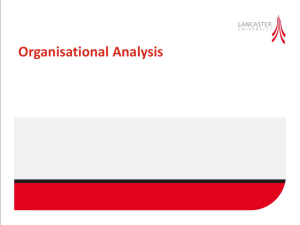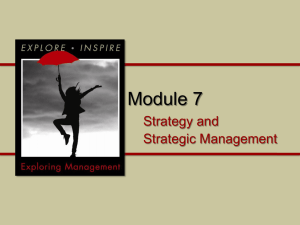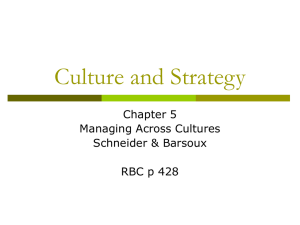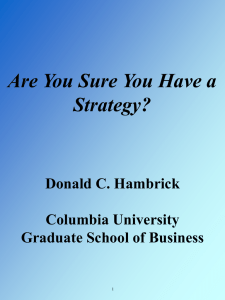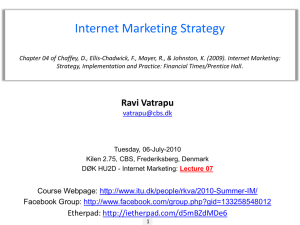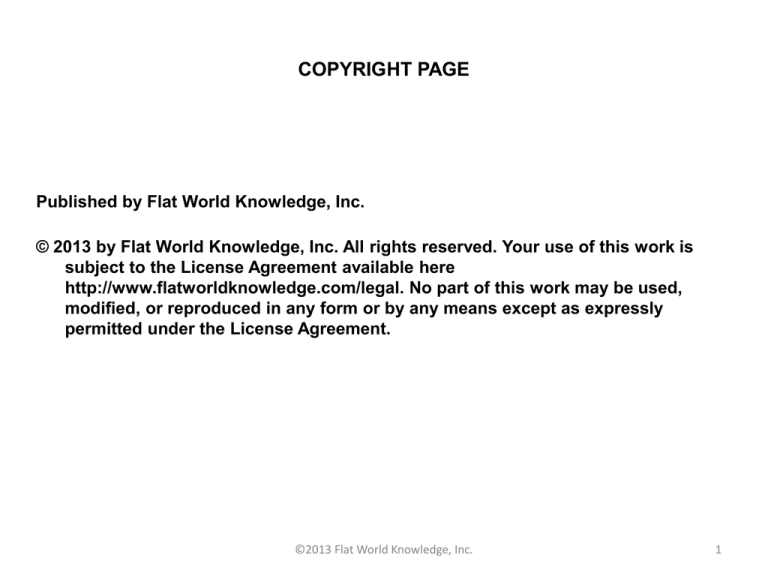
COPYRIGHT PAGE
Published by Flat World Knowledge, Inc.
© 2013 by Flat World Knowledge, Inc. All rights reserved. Your use of this work is
subject to the License Agreement available here
http://www.flatworldknowledge.com/legal. No part of this work may be used,
modified, or reproduced in any form or by any means except as expressly
permitted under the License Agreement.
©2013 Flat World Knowledge, Inc.
1
Principles of
Management 2.0
Mason Carpenter, Talya Bauer, Berrin Erdogan, and Jeremy Short
©2013 Flat World Knowledge, Inc.
2
Chapter 5
Strategic Management
Learning Objectives
© Jupiterimages Corporation
See how strategy fits in the
planning-organizing-leadingcontrolling (P-O-L-C)
framework
Better understand how strategies
emerge
Understand strategy as tradeoffs, discipline, and focus
Conduct internal analysis to
develop strategy
Conduct external analysis to
develop strategy
Formulate organizational and
personal strategy with the
strategy diamond
©2013 Flat World Knowledge, Inc.
3
Understand How Strategy Fits in the
P-O-L-C Framework
©2013 Flat World Knowledge, Inc.
4
Strategic Management Process
The process by which a firm
manages the formulation and
implementation of its strategy
• The coordinated means by which an
organization achieves its goals and
objectives
©2013 Flat World Knowledge, Inc.
5
Strategic Management Process
Strategy
Formulation
Strategy
Implementation
• The set of processes
involved in creating or
determining the strategies
of the organization
• The methods by which
strategies are
operationalized or executed
within the organization
©2013 Flat World Knowledge, Inc.
6
Strategizing in P-O-L-C
©2013 Flat World Knowledge, Inc.
7
Corporate and Business Strategy
©2013 Flat World Knowledge, Inc.
8
• Related Diversification
• Unrelated Diversification
Diversification
Synergy
Corporate
Strategy
©2013 Flat World Knowledge, Inc.
9
SWOT Analysis
An assessment of strengths, weaknesses, opportunities
and threats
What can
we do?
What do
we want to
do?
What
might we
do?
What do
others
expect us
to do?
©2013 Flat World Knowledge, Inc.
10
©2013 Flat World Knowledge, Inc.
11
Internal
Analysis Tools
External
Analysis Tools
Value
chain
PESTEL
VRIO
Industry
analysis
©2013 Flat World Knowledge, Inc.
13
Discussion
• What is the difference between strategy formulation and
strategy implementation?
• What is the difference between business strategy and
corporate strategy?
• What are some of the forms of diversification and what
do they mean?
• What do you learn from a SWOT analysis?
• In SWOT analysis, what are some of the tools you might
use to understand the internal environment (identify
strengths and weaknesses)?
• In SWOT analysis, what are some of the tools you might
use to understand the external environment (identify
opportunities and threats)?
©2013 Flat World Knowledge, Inc.
14
©2013 Flat World Knowledge, Inc.
15
Various Factors Can Undermine a Strategy
The plan is poorly constructed
Competitors undermine the advantages
envisioned by the plan
The plan was good, but poorly executed
©2013 Flat World Knowledge, Inc.
16
Intended, Deliberate, Realized, and
Emergent Strategies
©2013 Flat World Knowledge, Inc.
17
Discussion
• What is an intended strategy?
• What is a realized strategy?
• Why is it important to understand the
difference between intended and realized
strategies?
• Why is there not a perfect match-up between
realized and intended strategies?
• What might interfere with the realization of an
intended strategy?
©2013 Flat World Knowledge, Inc.
18
What is Strategic Focus?
Strategic focus is seen
when an organization
is very clear about its
mission and vision,
and has a coherent,
well-articulated
strategy for achieving
those.
strategy as
discipline
strategy as
trade-offs
©2013 Flat World Knowledge, Inc.
19
Porter’s Generic Strategies
©2013 Flat World Knowledge, Inc.
20
Differentiation or Price Leadership Strategy?
Southwest Airlines has
combined cost
cutting measures
with differentiation,
proving that it is
possible to succeed
using combination
strategies
© Jupiterimages Corporation
©2013 Flat World Knowledge, Inc.
21
Discussion
• What is strategic focus and why is it
important?
• What are Porter’s three generic
strategies?
• Can a firm simultaneously pursue a
low-cost and a differentiation
strategy?
©2013 Flat World Knowledge, Inc.
22
Developing Strategy Through Internal
Analysis
The primary purpose for internal analysis is to understand
the unique resources, capabilities, and core competencies
of organizations that may enable them to outperform
their competitors overtime.
©2013 Flat World Knowledge, Inc.
23
Measuring Value with
Core Competencies
Product’s
performance
characteristics
Value
Attributes for
which
customers are
willing to pay
©2013 Flat World Knowledge, Inc.
24
Resources and Capabilities
Resources
©2013 Flat World Knowledge, Inc.
25
Resources and Capabilities
Capabilities
©2013 Flat World Knowledge, Inc.
26
The Value Chain
©2013 Flat World Knowledge, Inc.
27
Adding
Value Within
a Value
Chain
©2013 Flat World Knowledge, Inc.
28
VRIO Analysis
Value
Rarity
Inimitability
Organization
©2013 Flat World Knowledge, Inc.
29
©2013 Flat World Knowledge, Inc.
30
Discussion
• What is the objective of internal analysis?
• What is the difference between a resource and a
capability?
• What is the difference between a tangible and an
intangible resource or capability?
• What is a core competency?
• What framework helps you identify those
resources, capabilities, or core competencies that
provide competitive advantage?
• Why might competitive advantage for a firm be
fleeting?
©2013 Flat World Knowledge, Inc.
31
DEVELOPING STRATEGY
THROUGH EXTERNAL ANALYSIS
An external
analysis tells
the strategist •Begin with
the general
what is
environment
outside the
organization.
©2013 Flat World Knowledge, Inc.
32
Six General Environment Segments
PESTLE Analysis
legal
political
environmental
technical
economic
social
©2013 Flat World Knowledge, Inc.
33
AN ORGANIZATION’S
MICROENVIRONMENT
Industry
• A group of firms producing products that are close
substitutes
• Upstream Markets: industries that provide the raw
material or inputs for the focal industry
• Downstream Markets: industries (sometimes
consumer segments) that consume the industry outputs
Industry
Microenvironment
• Consists of stakeholder groups that a firm has
regular dealings with.
• The way these relationships develop can affect
the costs, quality, and overall success of a
business.
©2013 Flat World Knowledge, Inc.
34
Porter’s Five Forces
©2013 Flat World Knowledge, Inc.
35
©2013 Flat World Knowledge, Inc.
36
Porter’s Attractiveness and
Profitability Analysis
Likely to Profit
Is the industry difficult to
enter?
Is there limited rivalry?
Are buyers relatively
weak?
Are suppliers relatively
weak?
Are there few
substitutes?
Challenges to Profit
Is the industry easy to
enter?
Is there a high degree of
rivalry between firms
within the industry?
Are buyers strong?
Are suppliers strong?
Is it easy to switch to
alternatives?
©2013 Flat World Knowledge, Inc.
37
Discussion
• What are the six dimensions of the environment
that are of broad concern when you conduct a
PESTLE analysis?
• Which of the PESTLE dimensions do you believe
to be most important, and why?
• What are the key dimensions of a firm’s
microenvironment?
• What are the five forces referred to in the Porter
framework?
• Is there a dimension of industry structure that
Porter’s model appears to omit?
©2013 Flat World Knowledge, Inc.
38
The Strategy Diamond
©2013 Flat World Knowledge, Inc.
39
Planning and Your Personal
Growth and Development Strategy
©2013 Flat World Knowledge, Inc.
40
Personal Arenas and
Differentiators
Personal Vehicles
• What type of work do I want to
do?
• What leisure activities do I
like?
• Where do I want to live?
• What capabilities
(differentiators) do I need to
participate in these arenas?
• What organizations value these
capabilities (differentiators)
• What capabilities
(differentiators) do I want to
have and excel in?
• What do I need to accomplish
on my own?
• What do I want to accomplish
on my own?
• What do I need to accomplish
with the help of others?
• Who are they?
©2013 Flat World Knowledge, Inc.
41
Personal Staging and Pacing
• What sequence of events does my
strategy require?
• What are the financial
requirements and consequences
of each event?
• What is my deadline for the first
event?
• Is the deadline flexible? Can I
manage the pacing of the
achievement of each event?
• How will timing affect
achievement of my personal
growth and development strategy
• Do some events provide an
opportunity to reconsider or
adjust my strategy?
Personal Economic Logic
• How does achievement of my
strategy help me pay the bills?
• What dimensions of my strategy,
like arenas or differentiators, is
the economic logic of my strategy
most dependent on?
• How sustainable is the economic
logic of my strategy?
©2013 Flat World Knowledge, Inc.
42
Discussion
• What are the five facets of the Hambrick & Fredrickson
strategy diamond?
• What is the relationship between arenas and
differentiators if the strategy yields a positive economic
logic?
• If a firm is performing poorly financially, what might
this say about the differentiators, arenas, or both?
• Why is it important to consider vehicles as part of an
organization’s strategy?
• What is the difference between staging and pacing in
terms of the strategy diamond?
• What are some ways that you might apply staging and
pacing to an organization’s strategy?
©2013 Flat World Knowledge, Inc.
43

